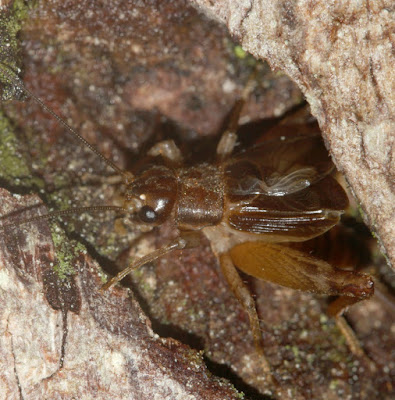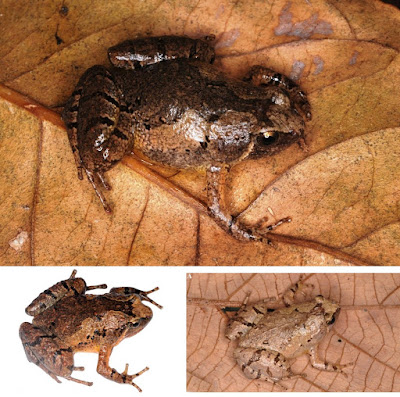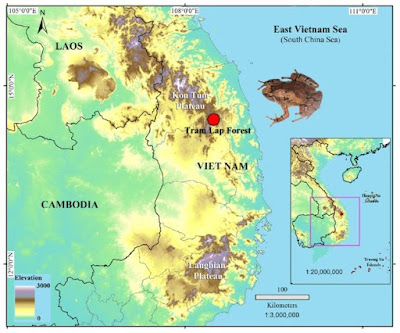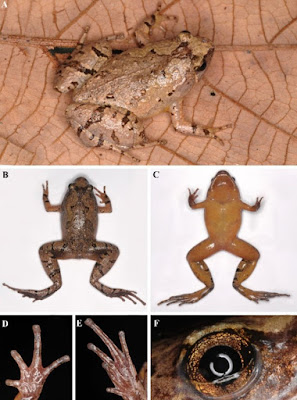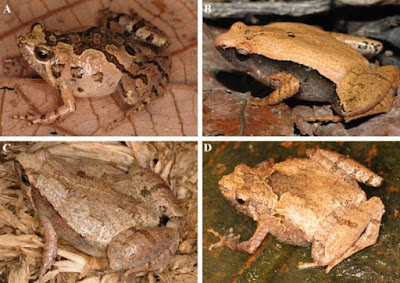[Most Recent Entries] [Calendar View]
Saturday, January 12th, 2019
| Time | Event | ||||||
| 9:12a | [Entomology • 2019] Endodrelanva siargaoensis • A New Species of Landrevinae (Orthoptera) from the Philippines, with Notes on Endodrelanva and Endolandrevus (Orthoptera: Gryllidae; Gryllinae; Landrevini)
Abstract Owing to the cryptic behavior and morphology of many Southeast Asian Landrevinae, new species are still being discovered in unexplored parts of the region. Here, we describe a new species: Endodrelanva siargaoensis sp. nov. We also recorded and describe the calling song of the new species. Owing to the morphological similarities between species of Endodrelanva Gorochov, 2000 and Endolandrevus Saussure, 1877, we also provide a short review of the two genera and list their characters for comparison. Keywords: Orthoptera, bioacoustics, biogeography, Grylloidea, Southeast Asia, taxonomy
Endodrelanva siargaoensis, new species Etymology. The species is named after the type locality, Siargao Island, which also represents the first record of the genus in the Philippines. Tan Ming Kai, Andrej V. Gorochov, Jessica B. Baroga-Barbecho and Sheryl A. Yap. 2019. A New Species of Landrevinae (Orthoptera) from the Philippines, with Notes on Endodrelanva and Endolandrevus (Orthoptera: Gryllidae; Gryllinae; Landrevini). Zootaxa. 4544(2); 285–295. DOI: 10.11646/zootaxa.4544.2.8 | ||||||
| 9:36a | [Herpetology • 2019] Microhyla aurantiventris • A New Species of the Genus Microhyla Tschudi, 1838 (Anura: Microhylidae) from Tay Nguyen Plateau, Central Vietnam
Abstract We describe a new species of Microhyla from Tram Lap forest, Gia Lai Province, Central Vietnam based on morphological, molecular, and acoustic data. The new species resembles M. butleri morphologically, but differs from all congeners by a combination of the following morphological attributes: (1) medium-sized adult snout–vent length 25.2–27.0 mm in 15 males and 30.5 mm in a single female; (2) body habitus moderately stocky; (3) head flat, snout rounded, slightly prominent in ventral profile; (4) dorsum and flanks slightly shagreened with evenly scattered tiny tubercles, ventral skin smooth; (5) first finger well developed, more than one-half the length of the second finger; (6) tips of three outer fingers slightly enlarged, forming weak disks and tips of all toes distinctly dilated into wide disks with narrow peripheral grooves; (7) finger and toe disks with dorsal median longitudinal grooves; (8) three palmar tubercles and two metatarsal tubercles; (9) tibiotarsal articulation of adpressed limb reaching slightly beyond the orbit; (10) webbing formula: I 1¾–2 II 1½–2¾ III 2–31/3 IV 3¼–1½ V; (11) in life, chin and throat yellowish to bright-orange with tiny dark brown speckling laterally; and (12) a call consisting of 15–26 pulses with a dominant frequency of 1.8–2.2 kHz (recorded at 18.5ºC). We also provide a preliminary genealogy of Microhyla based on analysis of a 2644 bp fragment of 12S–16S rRNA mitochondrial DNA. Based on the examed data, the new species and M. butleri are sister-species (genetic p-distance: 9.0%) and it can be distinguished from M. butleri by its morphology (size, webbing on toes, color) and advertisement call. Interspecific genetic p-distances between the new species and its congeners vary from 9.0% to 14.8%. Microhyla aurantiventris sp. nov. occurs in evergreen montane tropical forests at elevations around 1200 m a.s.l. and is known only from the type locality. The new species appears to be threatened due to intensive logging and agriculture plantation. Keywords: Amphibia, Acoustics, amphibians, mtDNA genealogy, Microhyla aurantiventris sp. nov., Microhylinae, Tram Lap Forest, Gia Lai Province  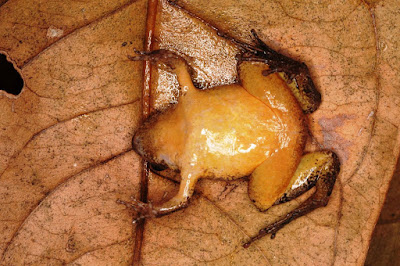
Microhyla aurantiventris sp. nov. Etymology. The specific name “aurantiventris” is a Latin adjective in the nominative singular, feminine gender, derived from “aurantiacus”—“orange-colored” and “venter”—“belly”, referring to the distinctive bright orange-yellow coloration of ventral surfaces in adult males of the new species. The recommended common name in English is “Orange-bellied narrow-mouth frog”. The recommended common name in Vietnamese is “Nhái bầu bụng vàng”. Distribution. Microhyla aurantiventris sp. nov. is currently known only from the type locality in ...., Gia Lai Province, Vietnam (Fig. 1). The species was recorded from elevation ca. 1210 m a.s.l. The distribution of the new species is unknown, and discovery of new localities within the Kon Tum Plateau is anticipated.  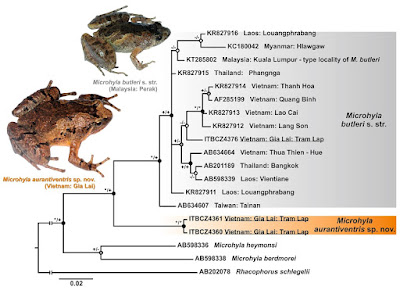
Luan Thanh Nguyen, Nikolay A. Jr. Poyarkov, Tiep Tan Nguyen, Tam Ai Nguyen, Vy Huu Tran, Vladislav A. Gorin, Robert W. Murphy and Sang Ngoc Nguyen. 2019. A New Species of the Genus Microhyla Tschudi, 1838 (Amphibia: Anura: Microhylidae) from Tay Nguyen Plateau, Central Vietnam. Zootaxa. 4543(4); 549–580. DOI: 10.11646/zootaxa.4543.4.4 |
| << Previous Day |
2019/01/12 [Calendar] |
Next Day >> |
